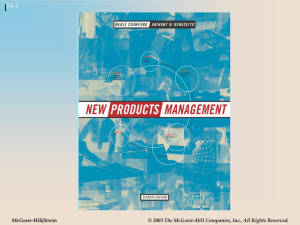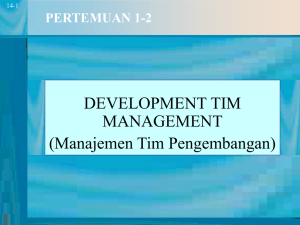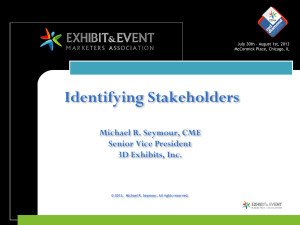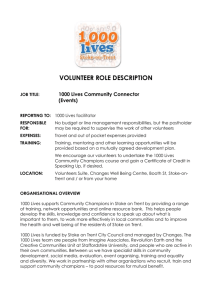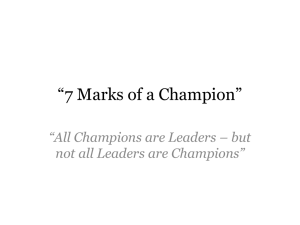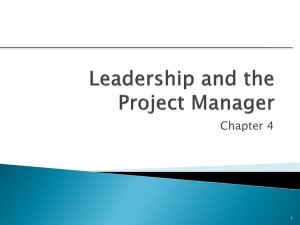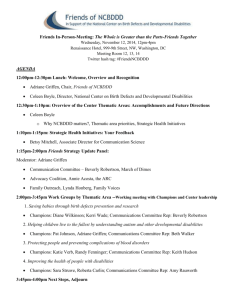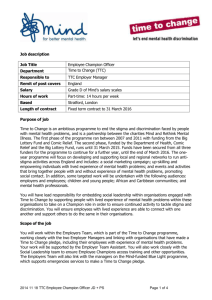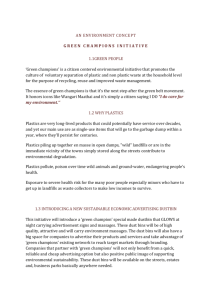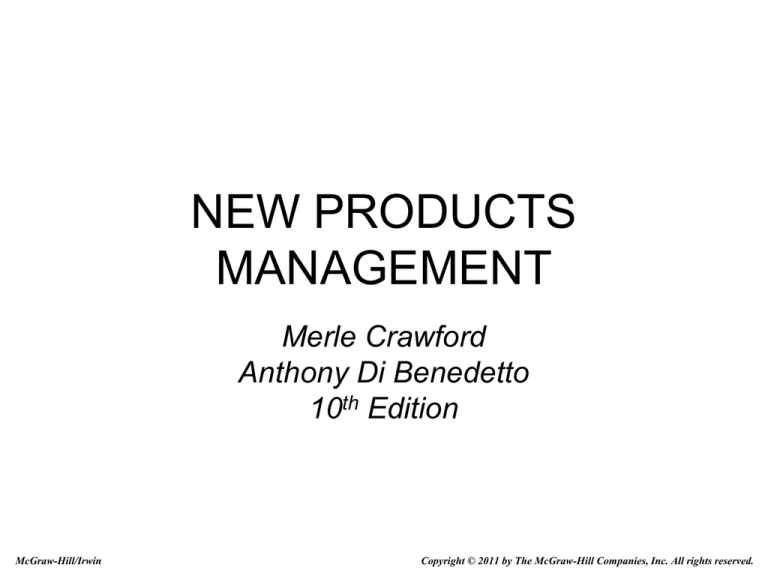
NEW PRODUCTS
MANAGEMENT
Merle Crawford
Anthony Di Benedetto
10th Edition
McGraw-Hill/Irwin
Copyright © 2011 by The McGraw-Hill Companies, Inc. All rights reserved.
Chapter 14
Development Team Management
14-2
Options in New Products Organization
1. Functional: work is done by the various departments, very little project focus.
– Usually a new products committee or product planning committee.
– Does not lead to much innovation.
2. Functional Matrix: A specific team with people from various departments;
project still close to the current business.
– Team members think like functional specialists.
– Departments call the shots.
3. Balanced Matrix: Both functional and project views are critical.
– May lead to indecision and delay.
– Many firms are making it work successfully.
4. Project Matrix: Team people are project people first and functional people
second.
– People may drive the project even against department’s best wishes.
5. Venture: Team members pulled out of department to work full time on
project.
These are listed in increasing projectization, defined as the extent to which
participants see themselves as committed to the project.
Other terms are lightweight vs. heavyweight: “heavier” means greater
projectization.
14-3
Examples of Venture Teams
• Lockheed’s “Skunkworks” was spun
outside of the company so that
researchers could concentrate on key
innovation targets.
• BMW sent designers from California and
Munich to their “Bank” design center in
London to learn Rolls-Royce culture and
develop the Phantom.
• The BMW Z4 sport coupe was similarly
designed by a dedicated venture team.
14-4
Difficulties with Venture or
Matrix Structures
• Many firms have moved back to a more
lightweight approach after finding venture teams
were difficult to establish and/or manage.
• Matrix structures are notoriously difficult to
manage, can get very complex, and can incur
high overheads (where does first priority lie, with
the team or the function?)
• In the extreme, matrix structures can even be
detrimental to innovation.
• Encouraging cooperation among team members
is most important.
14-5
Considerations when Selecting an
Organizational Option
• High projectization encourages cross-functional integration.
• If state-of-the-art functional expertise is critical to project
success (e.g., in a scientific specialty such as fluid dynamics),
a functional organization might be better, as it encourages the
development of high-level technical expertise.
• If individuals will be part of the project for only a short time, it
might make more efficient use of their time if they were
organized functionally. Industrial designers may be involved in
any given project for only a short time, so different projects
can simply draw on their expertise when needed.
• If speed to market is critical, higher projectization is preferred
as project teams are usually able to coordinate their activities
and resolve conflicts more quickly and with less bureaucracy.
PC makers often use project teams, as they are under severe
14-6
time pressure.
Who Are the Team Members?
• Core Team: manage functional clusters (e.g.,
marketing, R&D, manufacturing)
– Are active throughout the new products process.
• Ad Hoc Group: support the core team (e.g.,
packaging, legal, logistics)
– Are important at intervals during the new products
process.
• Extended Team Members: less critical members (e.g.,
from other divisions)
14-7
Building a Team
• Establishing a Culture of Collaboration
• Team Assignment and Ownership
– Empowered product champion
• Selecting the Leader
– A good general manager
• Selecting the Team Members
– Core and extended team members
14-8
Roles and Participants
• Project Manager
– Leader, integrator, mediator,
judge
– Translator, coordinator
• Project Champion
– Supporter and spokesperson
– May be the project manager
– Enthusiastic but play within the
rules
• Sponsor
– Senior executive who lends
encouragement and endorsement
to the champion
• Rationalist
– The “show-me” person
• Strategist
– Longer-range
– Managerial -- often the CEO
– Spelled out the Product Innovation
Charter
• Inventor
– Creative scientist
– “Basement inventor” -- may be a
customer, ad agency person, etc.
– Idea source
14-9
Myths and Truths About Product
Champions
The Myths:
The Truths:
• Champions are associated with
market successes.
• Champions are excited about
the idea.
• Champions get involved with
radical changes.
• Champions arise from high (or
low) levels in the firm.
• Champions are mostly from
• Champions get resources and
keep projects alive.
• They are passionate,
persuasive, and risk-taking.
• Champions work in firms with
or without formal new product
processes. Champions are
sensitive to company politics.
• Champions back projects that
align with the firm’s innovation
strategy.
marketing.
14-10
Guiding Principles in New Product
Process Implementation
Clarity of Goals and Objectives
Ownership
Leadership, at both senior and team levels
Integration with business processes
Flexibility
14-11
Issues in Team Management
• Cross-functional interface management
• Overcoming barriers to market orientation
(information flow across functional areas)
• Ongoing management of the team
• Team compensation and motivation
– Monetary vs. non-monetary rewards?
– Process-based vs. outcome-based rewards?
• Closing the team down
14-12
Five Conflict Management Styles
Conflict Management Style
Confrontation
Definition
Collaboratively solve the problem
to reach a solution the parties are
committed to.
Give and Take
Reach a compromise solution that
the parties find acceptable.
Withdrawal
Avoid the issue, or the
disagreeable party.
Smoothing
Minimize the differences and find
a superficial solution.
Forcing
Impose a solution.
Example
Debate the issue, conduct
customer interviews, generate
possible solutions, find the one
most supported by customers.
Negotiate a set of features to
build into the product, to keep the
project moving ahead.
Team members with unpopular
positions don't think it's worth the
trouble, and back out of the
decision.
Accommodate to the team
members that are strongly
committed to certain product
features, for the sake of group
harmony.
Project manager steps in and
makes the decisions.
Source: Adapted from David H. Gobeli, Harold F. Koenig, and Iris Bechinger, "Managing Conflict in
Software Development Teams: A Multi-Level Analysis," Journal of Product Innovation Management, Vol.
15, No. 5, September 1998, pp. 423-435.
14-13
Virtual Teams
• Teams that are linked electronically using
collaboration software.
• Can communicate despite geographic
dispersion.
• Synchronous or asynchronous mode.
• Challenges:
– Team members comfortable with technology
– Performance measurement and control
– Poor fit with firm values or cultures
• Firms may couple traditional plus virtual
meetings to avoid some of these issues.
14-14
Managing Globally Dispersed
Teams
• Reasons for growth:
– Increasing product complexity
– Accelerated product life cycles
– Multicultural group should lead to greater creativity
and problem solving, as long as communication
barriers can be overcome
• Issues:
– Levels of language skills among team members
– Physical distance among team members
– Cultural differences among team members
– Difficulties in competing design reviews
14-15
Successful Virtual Global Teams
• Boeing: used Web-based systems to integrate rocket engine
designers and partner firms across several locations worldwide.
• Xerox uses the Web to integrate designers in Rochester, NY,
engineers in Shanghai, and manufacturing plants in Hong Kong.
• Ford uses global platforms to support multiple brands where
each group does the engineering on one system for all vehicles
(one group does, for example, the exhaust system for all cars
sold globally on the same platform). Ford claims to have
achieved 60% savings in engineering costs as well as
successful launches.
• Digital’s global team has members in U.S. (several locations),
Switzerland, France, and Japan; uses audio conferencing for
early, casual discussion followed by computer conferencing at
stages.
14-16
Some Insights on Global Innovation
From Senior Executives
• Idea Generation:
– Leverage global knowledge.
– Source ideas from customers, employees,
distributors, etc.
• Product Development:
– Focus on incremental vs. home run breakthroughs.
– Share development costs.
– Use standardization to better manage global
operations.
• Commercialization:
– Early vs. late entrant decision.
– Consider local support/local partner.
14-17

